KW Bunonyo, IC Eli
Department of Mathematics & Statistics, Federal University Otuoke, Yenagoa, Nigeria
Correspondence to: KW Bunonyo, Department of Mathematics & Statistics, Federal University Otuoke, Yenagoa, Nigeria.
| Email: |  |
Copyright © 2019 The Author(s). Published by Scientific & Academic Publishing.
This work is licensed under the Creative Commons Attribution International License (CC BY).
http://creativecommons.org/licenses/by/4.0/

Abstract
In this paper, we investigated the oscillatory MHD viscoelastic flow in a porous channel with heat in the presence of magnetic field; the formulated equations governing the flow were solved analytically using perturbation method, and obtained the velocity and temperature profiles. In addition, we study the impact of the some of the pertinent parameters on the flow profiles in the flow profiles, that is, the way the pertinent parameters affects the velocity and temperature profiles in the porous channels with the oscillating in the presence of magnetic field. Finally, having carried out numerical computation using the pertinent parameters we observed that velocity and temperature profiles are greatly influenced by the following parameters 
Keywords:
Viscoelastic flow, Porous channel, MHD, Heat transfer, Magnetic field
Cite this paper: KW Bunonyo, IC Eli, Oscillatory MHD Viscoelastic Flow in a Porous Channel with Heat in the Presence of Magnetic Field, American Journal of Mathematics and Statistics, Vol. 9 No. 2, 2019, pp. 100-108. doi: 10.5923/j.ajms.20190902.05.
1. Introduction
The electrically conducting fluid flow has wide applications in several areas of engineering science which includes magnetohydrodynamic (MHD) generators, nuclear reactor, electromagnetic propulsion, geothermal energy extraction, boundary layer control in the field of aerodynamics, and plasma studies. In line with these applications, MHD flow in a channel has been studied by several authors, some of these authors include Nigam and Singh [1], vairavelu [2], Attia and Kotb [3] and soundalgekar and Bhat [4]. A Survey of MHD studies in the technological fields can be seen in moreau [5]. The fluid flow via porous media is a vital topic due to the recovery of crude oil from the pores of the reservoir rocks; in this case Darcy’s law represents the total effect. Raptis et al. [6] have investigated the hydromagnetic free convection flow via a porous media between two parallel plates. Aldoss et al [7] have investigated mixed convection flow from a vertical plate embedded in a porous media in the presence of a magnetic field. Makinde and Mhone [8] studies heat transfer or MHD Oscillatory flow in a channel filled with porous media. In this current research, we investigated the Oscillatory MHD viscoelastic flow in a porous channel with heat in the presence of magnetic field by formulated the governing equations for the problem and solve for the exact solutions using perturbation technique to decouple the coupled PDE and study the effect of the pertinent parameters on the flow profiles. [9] investigated the boundary-layer flow and heat transfer of a magnetohydrodynamic viscous fluid over a nonlinear radially porous stretching sheet within a porous medium and solutions are obtained using homotopy analysis method. In [10] studied the slip effects on the axisymmetric flow of an electrically conducting viscous fluid in the presence of a magnetic field over a non-linear radially stretching sheet adopting homotopy method. [11] Investigated Soret and Dufour effects with mixed convection are taken into account. The governing highly non-linear partial differential equations are transformed into the system of ordinary differential equations using similarity transformations. The resulting problems are computed by homotopy analysis method (HAM). In view of the above literature, we shall discuss an oscillatory MHD viscoelastic flow in a porous channel with heat in the presence of magnetic field by formulating governing equations for the momentum and energy equations and solving using perturbation method.
2. Mathematical Formulation
Consider the flow of an electrically conducting optically thin fluid in an oscillatory porous channel under the influence of externally applied homogenous magnetic field and radiative heat. It is assumed that the fluid has small electrical conductivity and small electromagnetic force. The  -axis is taken along the center of the channel and the
-axis is taken along the center of the channel and the  -axis is taken normal to it. For an incompressible fluid model, the equations governing the motion are as:
-axis is taken normal to it. For an incompressible fluid model, the equations governing the motion are as: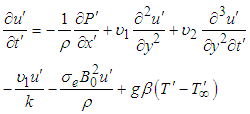 | (1) |
 | (2) |
Subject to the boundary conditions as: | (3) |
The following nondimensional quantities are introduced as: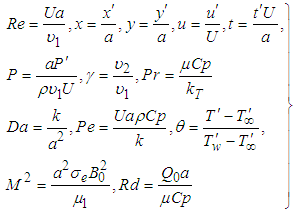 | (4) |
 | (5) |
 | (6) |
Subject to the boundary conditions as: | (7) |
3. Method of Solutions
In order to solve equation (5) and (6) for purely oscillatory flow in a channel, let  | (8) |
where  is a constant and
is a constant and  s the frequency of oscillation.
s the frequency of oscillation. | (9) |
 | (10) |
where Subject to the boundary conditions as:
Subject to the boundary conditions as: | (11) |
We can now solve equation (9) and equation (10) can be solved and the velocity and temperature profiles are as follows: | (12) |
 | (13) |
Substitute equation (12) into momentum equation, we have it as follows: | (14) |
Solving equation (14), we obtain the following: | (15) |
where 
 and
and  Putting equation (15) and (13) into equation (8), we obtain our velocity and temperature profile as follows:
Putting equation (15) and (13) into equation (8), we obtain our velocity and temperature profile as follows: | (16) |
 | (17) |
4. Graphical Results
 | Figure 1. Influence of  on velocity profile while other parameters values are on velocity profile while other parameters values are  |
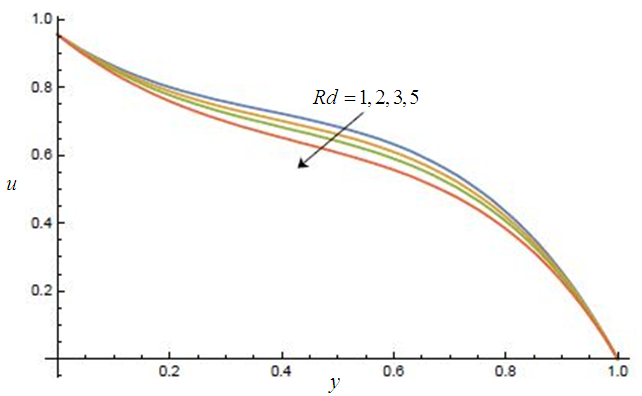 | Figure 2. Influence of  on velocity profile while other parameters values are on velocity profile while other parameters values are  |
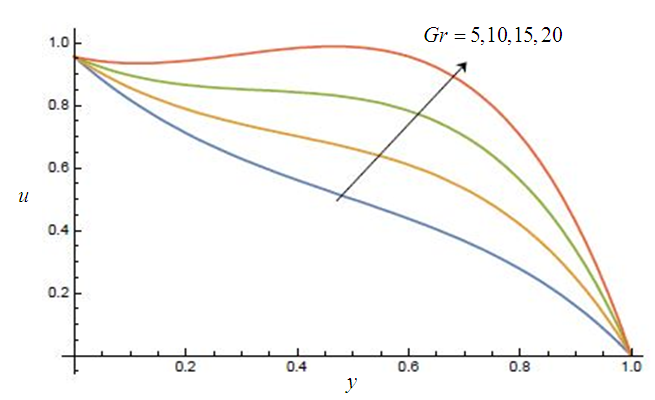 | Figure 3. Influence of  on velocity profile while other parameters values are on velocity profile while other parameters values are  |
 | Figure 4. Influence of  on velocity profile while other parameters values are on velocity profile while other parameters values are  |
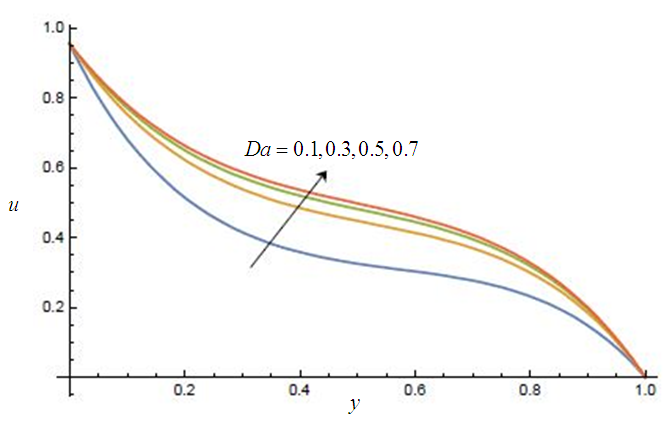 | Figure 5. Influence of  on velocity profile while other parameters values are on velocity profile while other parameters values are  |
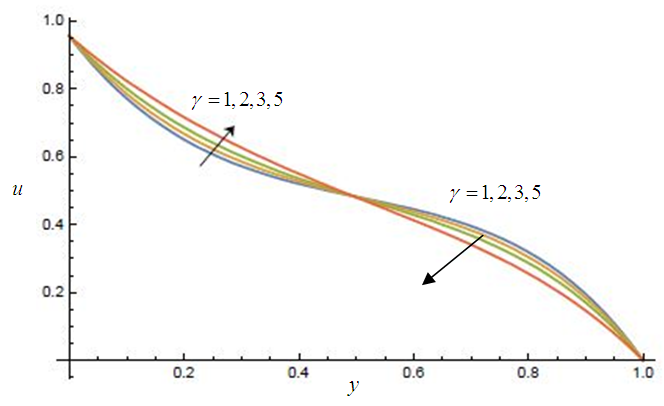 | Figure 6. Influence of  on velocity profile while other parameters values are on velocity profile while other parameters values are  |
 | Figure 7. Influence of  on velocity profile while other parameters values are on velocity profile while other parameters values are  |
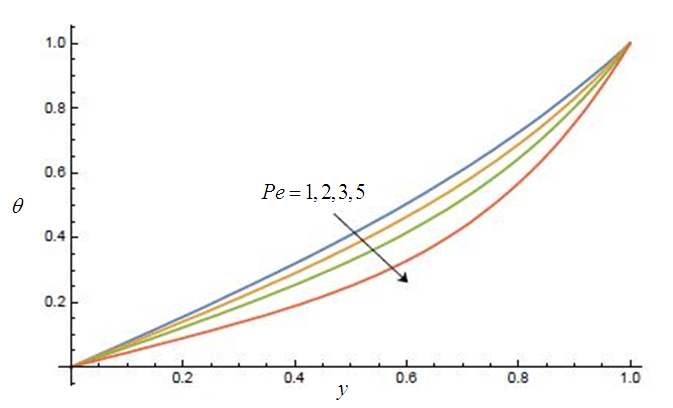 | Figure 8. Influence of  on temperature profile while other parameters values are on temperature profile while other parameters values are  |
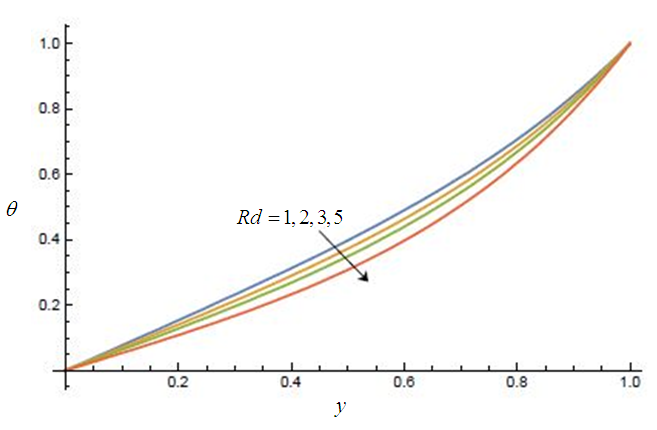 | Figure 9. Influence of  on temperature profile while other parameters values are on temperature profile while other parameters values are  |
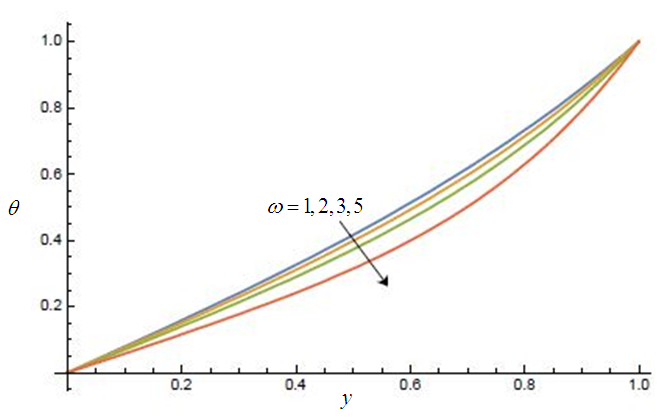 | Figure 10. Influence of  on temperature profile while other parameters values are on temperature profile while other parameters values are  |
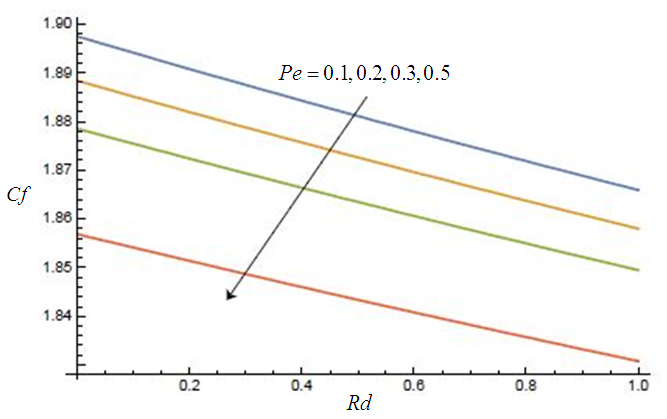 | Figure 11. Effect of  on skin friction coefficient while other parameters values remain on skin friction coefficient while other parameters values remain   |
 | Figure 12. Effect of  on skin friction coefficient with other parameters values on skin friction coefficient with other parameters values |
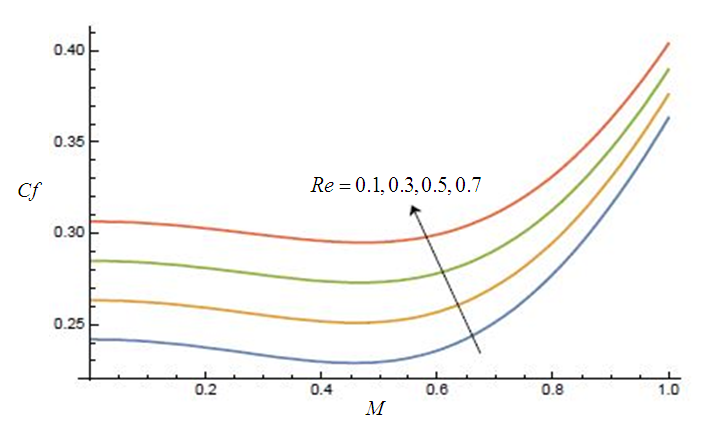 | Figure 13. Effect of  on Skin friction coefficient with other parameters values on Skin friction coefficient with other parameters values  |
 | Figure 14. Effect of  on Skin friction coefficient with other parameters values on Skin friction coefficient with other parameters values   |
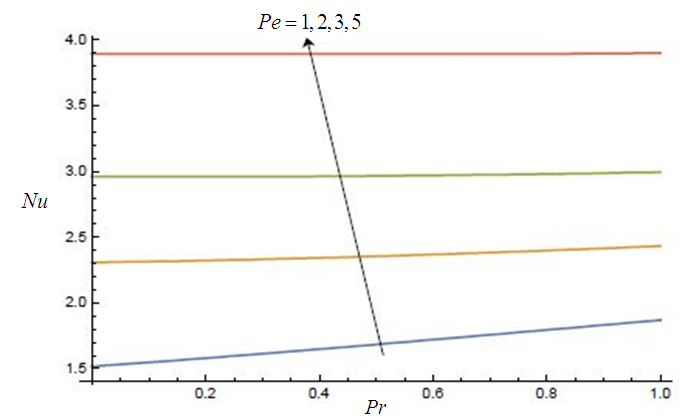 | Figure 15. Effect of  on Rate of heat transfer with other parameters on Rate of heat transfer with other parameters  |
 | Figure 16. Effect of  on Rate of heat transfer with other parameters on Rate of heat transfer with other parameters  |
5. Discussion
The investigation of the oscillatory MHD viscoelastic flow in a porous channel with heat in the presence of magnetic field has been carried out in the preceding sections. This has enabled us to carry out numerical computations for the velocity, temperature. However, this section provides the evidences, how the embedded parameters show their influence on velocity and temperature profiles. Several graphical results have been plotted and presented for the purpose of discussion. These graphs show the impact of magnetic parameter  , permeability parameter
, permeability parameter  , Peclete number
, Peclete number , Radiation parameter
, Radiation parameter  , Reynolds number
, Reynolds number  , Grashof number
, Grashof number  and viscolelastic parameter
and viscolelastic parameter  . Fig (1-8) are plotted to show the effects of these parameters on velocity profile
. Fig (1-8) are plotted to show the effects of these parameters on velocity profile  and Fig (9-11) show the influence of the parameters on temperature profiles
and Fig (9-11) show the influence of the parameters on temperature profiles  .The effect of
.The effect of  on the velocity profile indicated in Fig 1 that the profile decreases due to the increase in the parameter. Increasing values of
on the velocity profile indicated in Fig 1 that the profile decreases due to the increase in the parameter. Increasing values of  reduces the velocity, this physically indicates that the increasing values of magnetic parameter
reduces the velocity, this physically indicates that the increasing values of magnetic parameter  generate the resistive force also called the Lorentz force, which acts in the opposite direction to the fluid motion and resists the flow. Furthermore, it is clear in Fig 6 that increase
generate the resistive force also called the Lorentz force, which acts in the opposite direction to the fluid motion and resists the flow. Furthermore, it is clear in Fig 6 that increase  which has to do with the porous of medium, it reduces the drag force and increases the velocity. Fig. 3 is depicted to show the influence of
which has to do with the porous of medium, it reduces the drag force and increases the velocity. Fig. 3 is depicted to show the influence of  on the fluid velocity. It is observed that an increase in
on the fluid velocity. It is observed that an increase in  , leads to increase velocity due to enhancement in buoyancy force. Physically,
, leads to increase velocity due to enhancement in buoyancy force. Physically,  signifies the relative effect of the thermal buoyancy force to the viscous hydrodynamic force. Increasing values of
signifies the relative effect of the thermal buoyancy force to the viscous hydrodynamic force. Increasing values of  means an increase of temperature gradients due to which the contribution from the buoyancy near the boundary becomes significant and hence a short rise in the velocity near the boundary is observed.The effect of radiation parameter
means an increase of temperature gradients due to which the contribution from the buoyancy near the boundary becomes significant and hence a short rise in the velocity near the boundary is observed.The effect of radiation parameter  on the velocity is displayed in Figs. 2. It is observed that an increase in
on the velocity is displayed in Figs. 2. It is observed that an increase in  contributes to the decrease in the velocity profile. It means that the velocity decreases in the presence of low thermal radiation. Finally we can see that in Fig 3 that increase in Reynolds number leads to decrease in the velocity profile for the given values of the other pertinent parameters values.
contributes to the decrease in the velocity profile. It means that the velocity decreases in the presence of low thermal radiation. Finally we can see that in Fig 3 that increase in Reynolds number leads to decrease in the velocity profile for the given values of the other pertinent parameters values.
6. Conclusions
MHD oscillatory viscoelastic flow in a porous channel with heat in the presence of magnetic field was studied. Closed form solutions for velocity and temperature are obtained by solving the ODE directly haven converted the PDE using oscillatory perturbation technique. Thereafter, we did numerical computation to study the effect of the pertinent parameters with the following conclusions:(1) The velocity profile decreases with increasing values of the  and
and  .(2) Increase in
.(2) Increase in  enable the velocity of the fluid to increase due to greater permeability of the porous medium.(3) The velocity profile is influenced to increase due to the increase in Grashof number
enable the velocity of the fluid to increase due to greater permeability of the porous medium.(3) The velocity profile is influenced to increase due to the increase in Grashof number  .(4) The velocity profiles increases due to an increase in viscoelastic parameter
.(4) The velocity profiles increases due to an increase in viscoelastic parameter  but start to decrease at
but start to decrease at which produced a temperature value of about 0.437761 throughout.(5) In Fig (9-12) it is shown that increase in pertinent parameters lead to a corresponding decrease in temperature profile.
which produced a temperature value of about 0.437761 throughout.(5) In Fig (9-12) it is shown that increase in pertinent parameters lead to a corresponding decrease in temperature profile.
Nomenclature

References
| [1] | Nigam, S. D., & Singh, S. N. (1960). Heat transfer by laminar flow between parallel plates under the action of transverse magnetic field. The Quarterly Journal of Mechanics and Applied Mathematics, 13(1), 85-97. |
| [2] | Vajravelu, K. (1988). An exact periodic solution of a hydromagnetic flow in a horizontal channel. Journal of applied mechanics, 55(4), 981-983. |
| [3] | Attia, H. A., & Kotb, N. A. (1996). MHD flow between two parallel plates with heat transfer. Acta mechanica, 117(1-4), 215-220. |
| [4] | BHAT, J. (1984). Oscillatory MHD channel flow and heat transfer. Indian J. pure appl. Mam, 15(7), 819-828. |
| [5] | Moreau, R. (1990). Magnetohydrodynamics: Fluid Mechanics and Its Applications. |
| [6] | Raptis, A., Massalas, C., & Tzivanidis, G. (1982). Hydromagnetic free convection flow through a porous medium between two parallel plates. Physics Letters A, 90(6), 288-289. |
| [7] | Aldoss, T. K., Al-Nimr, M. A., Jarrah, M. A., & Al-Sha'er, B. J. (1995). Magnetohydrodynamic mixed convection from a vertical plate embedded in a porous medium. Numerical Heat Transfer, Part A: Applications, 28(5), 635-645. |
| [8] | Makinde, O. D., & Mhone, P. Y. (2005). Heat transfer to MHD oscillatory flow in a channel filled with porous medium. Romanian Journal of physics, 50(9/10), 931. |
| [9] | Shahzad, A., Ali, R., & Khan, M. (2012). On the exact solution for axisymmetric flow and heat transfer over a nonlinear radially stretching sheet. Chinese Physics Letters, 29(8), 084705. |
| [10] | Ali, R., Shahzad, A., Khan, M., & Ayub, M. (2016). Analytic and numerical solutions for axisymmetric flow with partial slip. Engineering with Computers, 32(1), 149-154. |
| [11] | Farooq, A., Ali, R., & Benim, A. C. (2018). Soret and Dufour effects on three dimensional Oldroyd-B fluid. Physica A: Statistical Mechanics and its Applications, 503, 345-354. |




 -axis is taken along the center of the channel and the
-axis is taken along the center of the channel and the  -axis is taken normal to it. For an incompressible fluid model, the equations governing the motion are as:
-axis is taken normal to it. For an incompressible fluid model, the equations governing the motion are as:







 is a constant and
is a constant and  s the frequency of oscillation.
s the frequency of oscillation.

 Subject to the boundary conditions as:
Subject to the boundary conditions as:





 and
and  Putting equation (15) and (13) into equation (8), we obtain our velocity and temperature profile as follows:
Putting equation (15) and (13) into equation (8), we obtain our velocity and temperature profile as follows:


 on velocity profile while other parameters values are
on velocity profile while other parameters values are 

 on velocity profile while other parameters values are
on velocity profile while other parameters values are 

 on velocity profile while other parameters values are
on velocity profile while other parameters values are 

 on velocity profile while other parameters values are
on velocity profile while other parameters values are 

 on velocity profile while other parameters values are
on velocity profile while other parameters values are 

 on velocity profile while other parameters values are
on velocity profile while other parameters values are 

 on velocity profile while other parameters values are
on velocity profile while other parameters values are 

 on temperature profile while other parameters values are
on temperature profile while other parameters values are 

 on temperature profile while other parameters values are
on temperature profile while other parameters values are 

 on temperature profile while other parameters values are
on temperature profile while other parameters values are 

 on skin friction coefficient while other parameters values remain
on skin friction coefficient while other parameters values remain 


 on skin friction coefficient with other parameters values
on skin friction coefficient with other parameters values

 on Skin friction coefficient with other parameters values
on Skin friction coefficient with other parameters values 

 on Skin friction coefficient with other parameters values
on Skin friction coefficient with other parameters values 


 on Rate of heat transfer with other parameters
on Rate of heat transfer with other parameters 

 on Rate of heat transfer with other parameters
on Rate of heat transfer with other parameters 
 , permeability parameter
, permeability parameter  , Peclete number
, Peclete number , Radiation parameter
, Radiation parameter  , Reynolds number
, Reynolds number  , Grashof number
, Grashof number  and viscolelastic parameter
and viscolelastic parameter  . Fig (1-8) are plotted to show the effects of these parameters on velocity profile
. Fig (1-8) are plotted to show the effects of these parameters on velocity profile  and Fig (9-11) show the influence of the parameters on temperature profiles
and Fig (9-11) show the influence of the parameters on temperature profiles  .The effect of
.The effect of  on the velocity profile indicated in Fig 1 that the profile decreases due to the increase in the parameter. Increasing values of
on the velocity profile indicated in Fig 1 that the profile decreases due to the increase in the parameter. Increasing values of  reduces the velocity, this physically indicates that the increasing values of magnetic parameter
reduces the velocity, this physically indicates that the increasing values of magnetic parameter  generate the resistive force also called the Lorentz force, which acts in the opposite direction to the fluid motion and resists the flow. Furthermore, it is clear in Fig 6 that increase
generate the resistive force also called the Lorentz force, which acts in the opposite direction to the fluid motion and resists the flow. Furthermore, it is clear in Fig 6 that increase  which has to do with the porous of medium, it reduces the drag force and increases the velocity. Fig. 3 is depicted to show the influence of
which has to do with the porous of medium, it reduces the drag force and increases the velocity. Fig. 3 is depicted to show the influence of  on the fluid velocity. It is observed that an increase in
on the fluid velocity. It is observed that an increase in  , leads to increase velocity due to enhancement in buoyancy force. Physically,
, leads to increase velocity due to enhancement in buoyancy force. Physically,  signifies the relative effect of the thermal buoyancy force to the viscous hydrodynamic force. Increasing values of
signifies the relative effect of the thermal buoyancy force to the viscous hydrodynamic force. Increasing values of  means an increase of temperature gradients due to which the contribution from the buoyancy near the boundary becomes significant and hence a short rise in the velocity near the boundary is observed.The effect of radiation parameter
means an increase of temperature gradients due to which the contribution from the buoyancy near the boundary becomes significant and hence a short rise in the velocity near the boundary is observed.The effect of radiation parameter  on the velocity is displayed in Figs. 2. It is observed that an increase in
on the velocity is displayed in Figs. 2. It is observed that an increase in  contributes to the decrease in the velocity profile. It means that the velocity decreases in the presence of low thermal radiation. Finally we can see that in Fig 3 that increase in Reynolds number leads to decrease in the velocity profile for the given values of the other pertinent parameters values.
contributes to the decrease in the velocity profile. It means that the velocity decreases in the presence of low thermal radiation. Finally we can see that in Fig 3 that increase in Reynolds number leads to decrease in the velocity profile for the given values of the other pertinent parameters values. and
and  .(2) Increase in
.(2) Increase in  enable the velocity of the fluid to increase due to greater permeability of the porous medium.(3) The velocity profile is influenced to increase due to the increase in Grashof number
enable the velocity of the fluid to increase due to greater permeability of the porous medium.(3) The velocity profile is influenced to increase due to the increase in Grashof number  .(4) The velocity profiles increases due to an increase in viscoelastic parameter
.(4) The velocity profiles increases due to an increase in viscoelastic parameter  but start to decrease at
but start to decrease at which produced a temperature value of about 0.437761 throughout.(5) In Fig (9-12) it is shown that increase in pertinent parameters lead to a corresponding decrease in temperature profile.
which produced a temperature value of about 0.437761 throughout.(5) In Fig (9-12) it is shown that increase in pertinent parameters lead to a corresponding decrease in temperature profile.
 Abstract
Abstract Reference
Reference Full-Text PDF
Full-Text PDF Full-text HTML
Full-text HTML